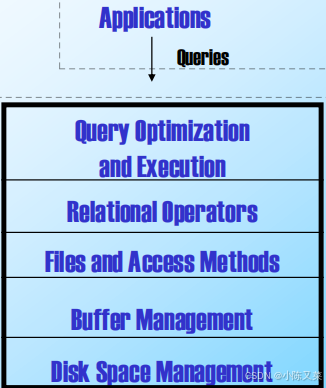目录
What can DBMS do for applications?
Levels of Abstractions in DBMS
Why DBMS?
- Suppose that you want to build an university database. It must store the following information:
- Entities: Students, Professors, Classes, Classrooms
- Relationships: Who teaches what? Who teaches where? Who teaches whom
What can DBMS do for applications?
- Store huge amount of data (e.g., TB+) over a long period of time
- Allow apps to query and update data
- Query: what is Mary’s grade in the “Operating System” course?
- Update: enroll Mary in the “Database” course
- Protect from unauthorized access
- Students cannot change their course grades.
- Protect from system crashes
- When some system components fail (hard drive, network, etc.), database can be restored to a good state
- Protect from incorrect inputs
Mary has registered for 100 courses
- Support concurrent access from multiple users
1000 students using the registration system at the same time
- Allow administrators to easily change data schema
At a later time, add TA info to courses.
- Efficient database operations
Search for students with 5 highest GPAs
Alternative to Using a DBMS
- Store data as files in operating systems.
- Applications have to deal with the following issues:
- 32-bit addressing (4GB) is insufficient to address 100GB+ data file
- Write special code to support different queries
- Write special code to protect data from concurrent access
- Write special code to protect against system crashes
- Optimize applications for efficient access and query
- May often rewrite applications
- Easier to buy a DBMS to handle these issues
这样说明,数据库管理系统是能够给我们提供大量方便的。
Data Models
- A data model is a collection of concepts for describing data
- Entity-relation (ER) model
- Relational model (main focus of this course)
- A schema is a description of data
- The relational model is the most widely used data model.
- A relation is basically a table with rows and columns of records.
Every relation has a schema, which describes the columns, or fields(字段)
Relational Model
The entire table shows an instance of the Students relation.

• The Students schema is the column heads
Students(Sid: String, Name: String, Login: String, age: Integer,… )
Levels of Abstractions in DBMS
Many views, one conceptual(概念模式)schema and one physical 、schema.
- Conceptual schema defines logical structure(概念模式定义的是逻辑结构)
- Physical schema describes the file and indexing used(物理模式定义的是文件和索引方式)
- Views describe how applications (users) see the data(储存的是一种数据之间的关系,并不 真实存在)
Example: University Database
- Conceptual schema:
- Students (sid: string, name: string, login: string, age: integer, gpa:real)
- Courses (cid: string, cname:string, credits:integer)
- Enrolled (sid:string, cid:string, grade:string) --选课表
- Physical schema:
Relations stored as unordered files. Index on first column of Students.
- View (External Schema):
Course_info(cid:string, enrollment:integer)
Data Independence
Three levels of abstraction provides data independence.
- Changes in one layer only affect one upper layer.
- E.g., applications are not affected by changes in conceptual & physical schema.
Queries in DBMS
- Sample queries on university database:
What is the name of the student with student ID 123456?
- The key benefits of using a relational database are Easy to specify queries using a query language: Structured Query Language (SQL)
SELECT S.name FROM Students S WHERE S.sid = 123456
- Efficient query processor to get answer
Transaction Management
• A transaction is an execution of a user program in a DBMS.
• Transaction management deals with two things:
- Concurrent execution of transactions(并发事务处理)
- Incomplete transactions and system crashes(事务回滚机制)
Concurrency Control
- Example
two travel agents (A, B) are trying to book one remaining airline seat (two transactions), only one transaction can succeed in booking.
- How to solve this?
Solution: use locking protocol(锁机制)
Transaction A: get exclusive lock on num_seats
Transaction B: wait until A releases lock on num_seats
Transaction A: if num_seats > 0, book & num_seat--;
// book the seat, num_seat is set to 0
Transaction A: release exclusive lock on num_seats
Transaction B: num_seats = 0, no booking;
// does not book the seat
Crash Recovery
- Example:
a bank transaction transfers $100 from account A to account B
A = A - $100
<system crashes> // good for the bank!
B = B + $100
- How to solve this?
Solution:use logging, meaning that all write operations are recorded in a log on a stable storage
A = A - $100 // recorded A value (checkpoint) in a log
<system crashes>
// start recovery: read the log from disk
//analyze, undo, & redo
Overview of DBMS

Layered Architecture

- 应用层
- 查询优化和执行层
- 关系操作符层
- 文件和访问方法层
- 缓冲管理层
- 磁盘空间管理层
要注意的是,这些分层架构都应该考虑到并发管理的问题
ApplicationArchitectures

- 两层架构:客户端和数据库系统(客户端程序使用数据库互接或者Java连接与数据库进行通信)
- 三层架构:客户端、应用服务器和数据库系统(给予Web的程序、使用中间件构建的应用程序)
 数据库管理系统全方位解析
数据库管理系统全方位解析






















 32
32

 被折叠的 条评论
为什么被折叠?
被折叠的 条评论
为什么被折叠?








